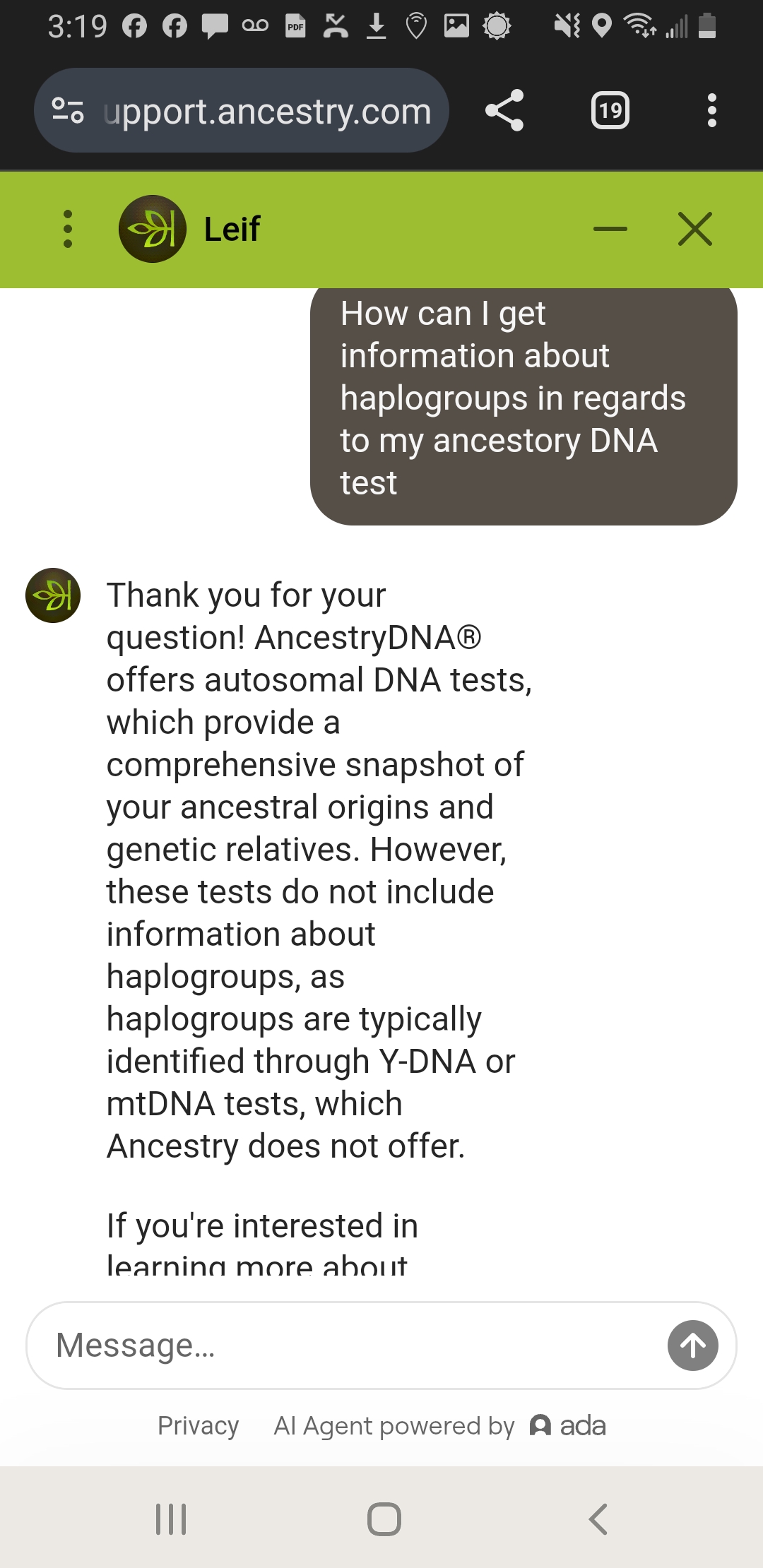Found attachment of size 397470.

Wed, 11 Jun 2025 17:09:10 -0700 marlon from private IP, post #17854717 /all haplogroups guess not Wed, 11 Jun 2025 17:35:37 -0700 zerosugar from private IP Reply #10466153 Do 23andme. You can see my post on 23 on thunderdome where I posted the file with my haplogroups. Your paternal is likely the same as mine E-v13. Another possibility is you have r1a. BTW, I can guess almost every poster’s haplogroup. Wed, 11 Jun 2025 17:36:56 -0700 zerosugar from private IP Reply #19392666 You would also have to take the test to know your paternal side, not your sister because it will only give her a maternal haplogroup in since women don’t have a y chromosome. I had to test my father to know mine. Wed, 11 Jun 2025 20:44:24 -0700 zerosugar from private IP Reply #19474225 my father's maternal haplogroup is also U5a1a. here is what i found on this u5 haplogroup: U5a1a is a specific mitochondrial DNA haplogroup (mtDNA haplogroup). It is a lineage within the larger U5 haplogroup, and it is primarily found in northwest and north-central Europe. The U5a1a maternal line is believed to have originated in Europe, likely before the expansion of agriculture, and has been associated with early populations that followed the retreat of glaciers. Here's a more detailed look: Origins and Distribution: U5a1a is thought to have originated in Europe, potentially in the Near East, and spread with early populations. Its distribution is mainly concentrated in northwest and north-central Europe. Ancient Connections: The presence of U5a1a in Europe predates the spread of agriculture, suggesting it was carried by early Mesolithic Western Hunter-Gatherers (WHG). Wed, 11 Jun 2025 20:55:38 -0700 zerosugar from private IP Reply #10964261 Back to paternal haplogroups, keep in mind some can be fairly widespread, but they can give clues into origins. I am most versed on European and Middle Eastern haplogroups and still do not have much info on other parts of the world. R1b is generally thought to be Western European. Its been found in Africa too. R1b is basically the most common in most Western European countries and even still the most common in Italy R1a is more Eastern European. Never found in Subsaharan Africa to my knowledge unlike R1b. I variants- found in Slavic groups and I think in some Nordic groups too. J2 likely has Anatolian origins. It spread west into Europe and east into the Levant. Extremely common amongst Jews. However, its presence in Europe also predates Jewish migration into Europe which likely means it spread in neolthic times to Western Europe. Today, J2 is second most common haplogroup in Italy. E-v13- Likely Balkan in origin. Most common in Balkans. Never found in subsaharan Africa, although other variants of E are found in subsaharan Africa. Also e-v13 is unique because it may show Ancient Greek migrations. Whats unique about e-v13 is it has survived in places where r1b and r1a are most common. articles on e-v13. https://pmc.ncbi.nlm.nih.gov/articles/PMC3068964/ https://www.reddit.com/r/23andme/comments/xh7q6j/im_fascinated_by_the_ydna_haplogroup_ev13_looking/ Wed, 11 Jun 2025 20:56:00 -0700 zerosugar from private IP Reply #16481155 Assimilation of Neolithic European E-V13 by the Indo-Europeans For many years the vast majority of academics have assumed that E-V13 and other E1b1b lineages came to the Balkans from the southern Levant via Anatolia during the Neolithic, and that the high frequency of E-V13 was caused by a founder effect among the colonisers. This theory has it that E1b1b people were associated with the development of Neolithic lifestyle and the advent of agriculture in the Fertile Crescent and its earliest diffusion to Southeast Europe (Thessalian Neolithic) and Mediterranean Europe (Cardium Pottery culture). The testing of ancient DNA from the Natufian culture (Mesolithic Levant) and Pre-Pottery Neolithic Levant confirmed a high incidence of haplogroup E1b1b in that region. However, out of 69 Y-DNA samples tested from Neolithic Europe, only two belonged to that haplogroup: one E-M78 from the Sopot culture in Hungary (5000-4800 BCE), another E-M78 (c. 5000 BCE), possibly E-V13, from north-east Spain, and a E-L618 from Zemunica cave near Split in Croatia from 5500 BCE (Fernandes et al., 2016). Whether these E-M78 samples came with Neolithic farmers from the Near East or were already present among Mesolithic Europeans is unclear at present. But in any case E-V13 was definitely not the major Neolithic European lineage it was once alleged to be. Nowadays E-V13 is the only Mediterranean haplogroup consistently found throughout Europe, even in Norway, Sweden, Finland and Baltic countries, which are conspicuous by the absence of other Neolithic haplogroups like G2a (bar the Indo-European G2a-Z1815), J1 and T (except in Estonia). However, since G2a is the only lineage that was consistently found in all Neolithic sites tested to date in Europe, the absence of Neolithic G2a lineages from Scandinavia and the Baltic implies that no Neolithic lineage survives there, and consequently E-V13 does not date from the Neolithic in the region. In fact, it has been calculated that E-V13 emerged from E-M78 some 7,800 years ago, when Neolithic farmers were advancing into the Balkans and the Danubian basin. Furthermore, all the modern members of E-V13 descend from a common ancestor who lived approximately 5,500 years ago, and all of them also descend from a later common ancestor who carried the CTS5856 mutation. That ancestor would have lived about 4,100 years ago, during the Bronze Age. Almost immediately afterwards, CTS5856 split into six subclades, then branched off into even more subclades in the space of a few generations. In just a few centuries, that very minor E-V13 lineage had started an expansion process that would turn it into one of Europe's most widespread paternal lineages and reach far beyond the borders of Europe itself, also spreading to the eastern edge of the Mediterranean, the Caucasus, Kurdistan, Iran, and even Siberia. This data suggests that the fate of E-V13 was linked to the elite dominance of Bronze Age society. The geographic distribution of the six main branches show that E-V13 quickly spread to all parts of Europe, but was especially common in Central Europe. The only Bronze Age migration that could account for such a fast and far-reaching dispersal is that of the Proto-Indo-Europeans. At present the most consistent explanation is that E-V13 developed from E-M78 in Central or Eastern Europe during the Neolithic period, and was assimilated by the R1a and R1b Proto-Indo-Europeans around the time that they were leaving the Pontic Steppe to invade the rest of Europe. What is surprising with E-V13 is that it is as common in R1a-dominant as in R1b-dominant countries. R1a Indo-European tribes are associated with the Corded Ware culture, which spanned across Northeast Europe, Scandinavia and the northern half of Central Europe. R1b tribes invaded the Balkans, the southern half of Central Europe, and joined up with Corded Ware people in what is now Germany, the Czech Republic and western Poland. If E-V13 was found among both groups, it would have needed to be either assimilated in the Pontic Steppe or very near from it (say, in the Cucuteni-Trypillian culture, around western Ukraine, Moldova and Romania), or at the junction between the two groups in central Europe (e.g. around the Czech Republic). The distribution and age of E-V13 clades in central and western Europe are consistent with a dispersal by Hallstatt and La Tène Celts, Italic tribes (including a Roman redistribution) and the later influx of Germanic tribes, particularly the Goths, who may have assimilated additional Proto-Slavic E-V13 lineages in East Germany, Poland and Ukraine before entering the Roman Empire. (=> see also the discussions Was E-V13 a major lineage of Hallstatt Celts and Italics? and Ancient East, West and North Germanics had different Y-DNA lineages). source- https://www.eupedia.com/europe/Haplogroup_E1b1b_Y-DNA.shtml Wed, 11 Jun 2025 20:57:02 -0700 zerosugar from private IP Reply #17649773 https://www.biorxiv.org/content/10.1101/2023.06.05.543790v1.full.pdf Wed, 11 Jun 2025 20:58:38 -0700 zerosugar from private IP Reply #17441179 I also realize I mentioned J2, but forgot J1. While J2 is Anatolian that spread east and west. J1 is Arabian peninsula in origin. While J1 can be found in the Levant, its important to note that its likely not native to the Levant, but rather J1 spread west with Arab colonization of the Levant. Wed, 11 Jun 2025 21:04:05 -0700 zerosugar from private IP Reply #18775252 tl;dr r1b- western european r1a-eastern european e-v13-present where there is both r1b and r1a. j2- anatolian in origin, spread east and west. j1- arabian gulf origins i variants-various slavic and nordic countries. note even within these groups, there are variants. maternal haplogroups are more widespread than paternal and would take forever to go through them all. Wed, 11 Jun 2025 21:08:09 -0700 zerosugar from private IP Reply #16871724 i noticed bernie sanders also got j2 when he did a dna test. lol. https://www.igenea.us/en/famous-people/berniesanders there is also some belief j2 could have started in iran. either way, its most common in levant, but also spread to western europe.Replies require login.
